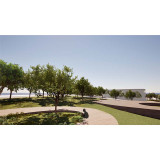This thesis focuses on the regeneration of the riverside area in the city of Aridaia. The riverside area is located on the outskirts of the city and serves as a key point of connection with the Moglenitsa River, the provincial road, and the nearby residential zone. Additionally, a significant part of the area is characterized by dense vegetation. However, it remains unutilized, depriving the city's residents of the opportunity to connect with nature and access more activities, such as sports and cultural events. Specifically, the swimming pool and the covered market building have been abandoned for more than 15 years. Furthermore, the city lacks a library, as well as a cinema and an event space.
The design strategy followed involves the creation of different zones that aim to address these needs. To this end, in the first zone, which connects with the bus terminal (KTEL) and the schools, the following buildings are introduced: a library, the Municipal Water and Sewerage Company (DEYA), and a swimming pool. The covered market building, which is currently partially used as a bus terminal, is repurposed and divided into two functions: a bus terminal and a cinema. A key aspect of the proposal is the enhancement of the area's natural wealth. For this reason, pathways, plantings, flower beds, and some shelters are introduced. The regeneration also includes agricultural cultivations, which are of great importance to the city and the surrounding villages, as agriculture is a major occupation for the residents, as well as sports fields to promote athletic activities.
The choice of curvilinear and organic forms, both in the buildings and the pathways, was made to create a landmark in the city and emphasize the natural flow and fluidity that stem from the river and the rich vegetation of Almopia—elements that are currently lacking within the urban fabric. The area was treated as an extension of the “Dasaki” park, which, despite being located outside the urban core, serves as a place of relaxation and a vital green space for the residents.
